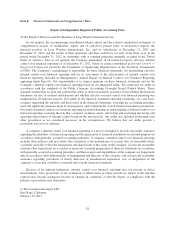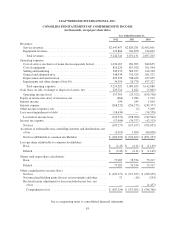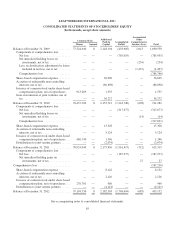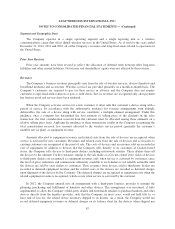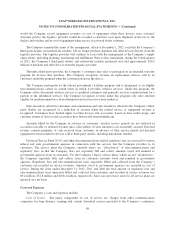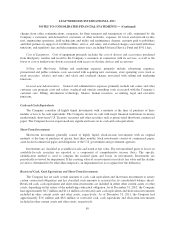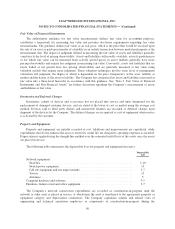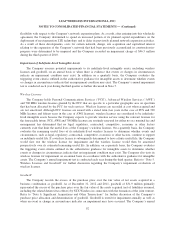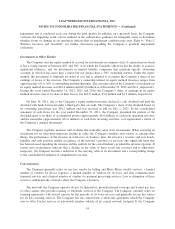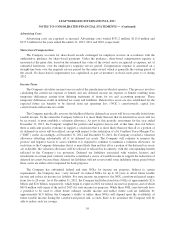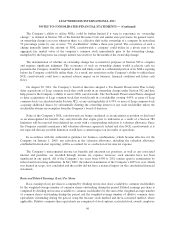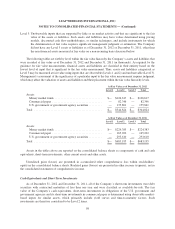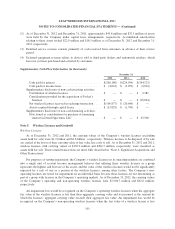Cricket Wireless 2012 Annual Report Download - page 105
Download and view the complete annual report
Please find page 105 of the 2012 Cricket Wireless annual report below. You can navigate through the pages in the report by either clicking on the pages listed below, or by using the keyword search tool below to find specific information within the annual report.LEAP WIRELESS INTERNATIONAL, INC.
NOTES TO CONSOLIDATED FINANCIAL STATEMENTS — (Continued)
construction period to the extent time and expense are attributed to the construction effort. The Company also
capitalizes certain telecommunications and other related costs as construction-in-progress during the construction
period to the extent they are incremental and directly related to the network under construction. In addition,
interest is capitalized on the carrying values of both wireless licenses and equipment during the construction
period and is depreciated over an estimated useful life of ten years. During the years ended December 31, 2012
and 2011, the Company did not capitalize any interest to property and equipment.
In accordance with the authoritative guidance for accounting for costs of computer software developed or
obtained for internal use, certain costs related to the development of internal use software are capitalized and
amortized over the estimated useful life of the software. During the years ended December 31, 2012 and 2011,
the Company capitalized internal use software costs of $74.4 million and $88.6 million, respectively, to property
and equipment, and amortized internal use software costs of $76.7 million and $56.5 million, respectively.
Long-Lived Intangible Assets
The Company’s long-lived intangible assets consist of trademarks and customer relationships. The
Company’s trademarks were recorded upon adoption of fresh-start reporting and are being amortized on a
straight-line basis over their estimated useful lives of fourteen years. Customer relationships acquired in
connection with the Company’s acquisition of Hargray Wireless, LLC (“Hargray Wireless”) in 2008 and the
formation of the STX Wireless joint venture in the fourth quarter of 2010 are amortized on an accelerated basis
over a useful life of up to four years. Amortization expense for other intangible assets for the years ended
December 31, 2012, 2011 and 2010 was $16.8 million, $23.4 million and $10.1 million, respectively. Estimated
amortization expense for other intangible assets is $10.6 million for 2013, $4.6 million for 2014, $2.6 million for
2015, $2.6 million for 2016, $2.6 million for 2017 and $1.5 million thereafter.
Impairment of Long-Lived Assets
The Company assesses potential impairments to its long-lived assets, including property and equipment and
long-lived intangible assets, when there is evidence that events or changes in circumstances indicate that their
respective carrying values may not be recoverable. An impairment loss may be required to be recognized when
the undiscounted cash flows expected to be generated by a long-lived asset (or group of such assets) are less than
its carrying value. Any required impairment loss would be measured as the amount by which the asset’s carrying
value exceeds its fair value and would be recorded as a reduction in the carrying value of the related asset and
charged to results of operations.
During the fourth quarter of 2012, in connection with the Company’s plans to reduce its previously planned
network expansion activities and overall capital expenditures, certain projects relating to network design, site
acquisition and other internal corporate initiatives were canceled. Therefore, the Company determined that
certain capitalized amounts were no longer recoverable, and as such, recorded an impairment charge of $13.6
million during the fourth quarter of 2012, reducing the carrying value of those capitalized amounts to zero. There
were no other events or circumstances that occurred during the year ended December 31, 2012 that indicated the
carrying value of any long-lived assets may not be recoverable.
There were no events or circumstances that occurred during the year ended December 31, 2011 that
indicated the carrying value of any long-lived assets may not be recoverable.
In August 2010, the Company entered into a wholesale agreement, which it uses to offer Cricket services in
nationwide retailers outside of its current network footprint. This agreement has enabled the Company to
strengthen its retail presence in its existing markets and expand its distribution nationwide, and provided greater
91


